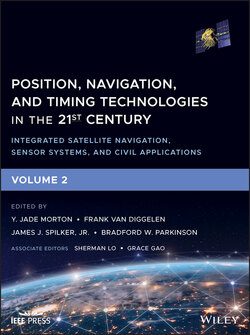Читать книгу Position, Navigation, and Timing Technologies in the 21st Century - Группа авторов - Страница 122
38.9.3 Experimental Results
ОглавлениеTo demonstrate the performance of the cellular‐aided INS, a UAV was flown in an environment comprising three cellular CDMA BTSs and two LTE eNodeBs, whose locations were pre‐surveyed and are illustrated in Figure 38.66(a) [6]. The UAV was equipped with a consumer‐grade IMU, a GPS receiver, and the cellular CDMA and LTE navigation receivers discussed in Sections 38.5 and 38.6. Experimental results are presented for two scenarios: (i) the cellular‐aided INS described in Subsection 38.9.1 and (ii) for comparative analysis, a traditional GPS‐aided INS using the UAV’s IMU. The true trajectory traversed by the UAV is plotted in Figures 38.66(b)–(c) and consists of GPS unavailability for 50 s, starting at a location marked by the red arrow. The north‐east RMSE of the GPS‐aided INS’s navigation solution after GPS became unavailable was more than 100 m. The UAV also estimated its trajectory using the cellular‐aided INS framework using signals from the three CDMA BTSs and two eNodeBs to aid its onboard INSs. Table 38.7 summarizes the UAV’s 2D and 3D RMSEs and final errors.
Table 38.7 UAV’s RMSEs and final errors after 50 s of GPS cutoff
| 2–D RMSE (m) | 3–D RMSE (m) | Final 3–D error (m) | |
|---|---|---|---|
| INS only | >100 | >100 | >100 |
| Cellular‐aided INS | 4.68 | 7.76 | 4.92 |
